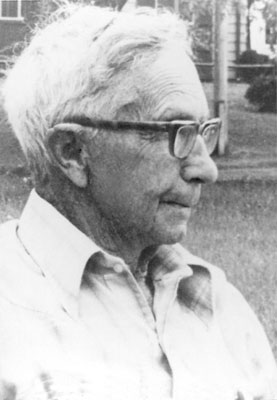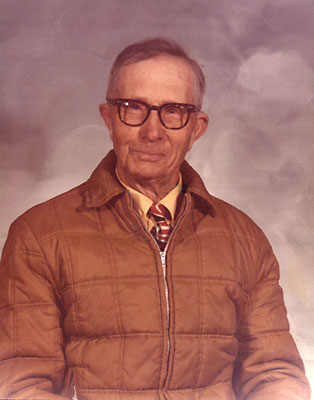 |
||
|
A life history by Clifton Morgan followed by a history by his wife Velma
|
|||
|
My parents were Thomas William Morgan and Lavina Ross Morgan. I was born at Neeley, (Power County) Idaho.(Power county was then Oneida county. It was later divided into two counties). I went to school in a log one room schoolhouse. My first teacher that I can remember was Helen Neeley. The house I was born in was a log house with a dirt roof and cloth for the ceiling. William Neeley was Bishop and my dad and Joe Woods were his counselors. There was no ward at American Falls at that time. I was baptised in Warm Creek. The water was warm from a hot spring. When I was nine, ten, and eleven, I worked for (Uncle) Ted Morgan riding derek (derrick) for twenty five cents a day, twelve hours a day. The men got $1.50 per day. You could buy a pair of shoes for $1.25 - 1.75 at that time. There was only one bill to pay and that was groceries. We used coal oil lamps and burned wood. There were many immigrants coming from the east going to Oregon, Washington, and California. This was about the time they were building the railroad across the desert and building the bridge across the Snake River. Sometimes they would lose some of their (railroad) ties in the river and they paid dad fourteen cents apiece to get them out of the river. There was one store, a post office and two saloons in American Falls. Many roughnecks used to stop there. There were about twelve families in the ward. They were Neeley's, Sorensen (two farmilies), Joe Woods, Thomas Thornton, Henry Bartholomew, George Stanger, Charles Stanger, William Johnson, Emil Jones, Heber Dillie, Tom Richardson. There were more families to come later. The creek was divided up equally to those who held land. Uncle Ted Morgan, Willard Moore, and grandfather Ross stayed there about one year and then moved up to Shelton. Then there was a man by the name of Walker who moved there with two women. George Stanger had two wives. We held church in the schoolhouse. When I was sixteen I was set apart as a ward teacher. I went with Rasmus Hansen (Rast Hansen was married to Clifton's Aunt Julia). We took turns going after the missionaries who would come down from Pocatello. We were in the Pocatello stake. About 1905 they started to build a new church house. The basement was dug with shovels and slip scrapers. We hauled rock from the foothills. They made thier own bricks. I had a friend named George Johnson. We were always together. We would go up in the hills and stay for two or three days at a time. We went to school together but George would never go to church. We did lots of mean things but nothing too serious. I was ordained a teacher and then a priest. We put up a store one time but that didn't last very long. Sunday school started at 10, sacrament meeting at 2 and mutual at 7:30. They always stood up to sing. George and I had our driving team and saddle horses. We carried our six shooters when we were on horseback. We always had our outfit in the fourth of July parade. Sometimes we would go to American Falls for five cents worth of candy. We would get a large sack for five cents. I started working for the Bureau of Reclamation measuring the river water. I had to check the guage every day for about one year. They sent a machine to do it and I only had to change the sheets once a week after that. They they started to dry farm in the foothills. You could grow most anything on the dry farm. You could raise two or three crops on one plowing. That continued for about ten years. Then the Jim Hill Mustard started growing in the wheat until you couldn't cut the grain. Then we started to summer fallow. (leaving the land fallow every other year) We got rid of the mustard but then the Russian Thistle came. It grew taller than the grain. They nearly got rid of the thistle and then the drought came. Many of the farmers started to leave their farms to find work. That continued for about three years and the whole country went to June Grass. When it got ripe in the fall someone set fire to it. We had a great prairie fire which burned many homes, barns, and fences. There were only a few farmers left in the dry farm section. most of the land was sold for taxes. We got the church house finished and a new bishop was put in. Bishop Bennion stayed in about five years. Then Joseph Morris was bishop. He moved away and the ward was nearly broken up. The books were scattered around. Then they finally joined the American Falls ward. All the old timers left Neeley but two or three families. I was ordained an elder in Pocatello, February 27, 1908 by bishop Joseph Morris. I was first counselor in the mutual for three years and I had to take charge most of the time. It was at this time that I met my wife, Velma, and we were married in Pocatello, December 28, 1910. We lived on the dry farm for about ten years. We organized a sunday school and I took charge there for two years. We brought several into the church. We had some wonderful times. We held our sunday school in a school house; and we got a lot of our books from Neeley after the ward was joined onto the American Falls ward. We went to the Salt Lake Temple October 15, 1912 traveling with a team and wagon. We leased some land on the reservation and farmed there.
In the picture above is Clifton (Dick) Morgan The following section was written by Clifton's wife Velma. I was married at seventeen so didn't have much childhood life. I married Clifton Morgan on December 28th, 1910 at Pocatello, Idaho. For our honeymoon trip we went by team and wagon to Yellowstone Park all the way from American Falls. We got as far as the entrance to the park, [and we were so tired that we] turned around and went back home. Two years later we went, again by team and wagon, to the Salt Lake Temple and were married for time and eternity. When I was twenty years old my first baby was born, a girl we named Anna Lorene. The next three years brought three baby sons, Dale, Veril and Stanley. On the 10th of January, 1919 my husband's mother died suddenly and was buried in the Neeley cemetery near American Falls. On the 8th of May 1919 my father died. In 1924 we had a baby girl, Marva, and two years later Donna was born. When Donna was three weeks old we moved to Stevensville, Montana. The Jim Sorensen family moved along with us. We had been farming on the Indian Reservation near Fort Hall, Idaho. The Indians used to come to our house and ask for biscuits, or anything we would give them. The railroad company offered to move us and our belongings to Montana if we would go up there and help settle the country. We loaded our household possessions in one box car and our livestock in another. When we got there the neighbors were so friendly and helpful, gave us food to eat, invited us to their entertainments and offered to help us build our houses. We built a good house and had a good farm, but there were only three LDS families there. We had one of the best herds of cattle in the country. People were always stopping in, trying to buy them from us. One day a man came along and offered us such a good price that we finally sold out. We bought a few more cattle and moved to Drummond, Montana, about 100 miles away. We always referred to this as the "bad move." Dale and Veril were about ten and eleven then, and they helped drive the cattle. They still talk about that trip. One night when they were camped along the way they got to playing too many tricks and dad chased them out into the sagebrush barefooted. Another time they set a bridge on fire! Our kids went to school at the Lone Rock School. Our son, Stanley, was in the 4th grade. The teacher thought he was too little to be in the fourth grade so she put him back a year. We soon became homesick and moved back to Idaho. Dad's brother Jack came up and helped us move back. He rode in the boxcar with the cattle. Just as they left our dog "Badger" jumped out of the box car and was left behind. We thought for sure he was lost for good, but about three weeks later we were on our way from Grandpa Morgan's place near Ririe [where they were staying] to Idaho Falls when we saw the dog, limping along the road. We stopped the car and he jumped in and a happy reunion that was! We turned around and went back to Grandpa's and doctored his sore paws. He had trailed us all the way from Montana. We rented a farm near Idaho Falls [1/2 mile North of the county line on Buck Road] and lived there for about a year, then moved up to the Clark Ward. After a few years [about 1947] we were able to buy our own [100 acres on Shelton Road] farm [for $3500.00]. The Garrick Fillmore family lived across the road from us for many years and we enjoyed them very much. We now had two more boys, Gene and Lynn. The following section is taken from a life history of Clifton Morgan written by his daughter Marva Morgan Quinton. It was while they were living on the Indian Reservation that the Union Pacific Railroad offered free land to any farmer willing to move to Montana to help settle the country up there. This seemed like a golden opportunity, so in 1926, when Donna was just three weeks old, they set off on their adventure. They traveled in a boxcar with their livestock loaded into a second car. They settled near Stevensville, where they had a good farm, a nice herd of livestock and were doing very well. After about two years Grandpa (Clifton) got "itchy feet" and wanted to move on, so they sold out and moved themselves about 100 miles away to Hall, Montana. They loaded their possessions into wagons and the boys drove the cattle. It was an adventure they often talk about to this day. They always refer to this as "the bad move" because they ended up being more isolated and homesick than ever and after about two years they gave up and moved back to Idaho. The section below was extracted from histories of Velma Morgan written by Clifton and Velma's daughter Marva Morgan Quinton about 1973. Grandma (Velma) was the second oldest of her family and she has lived to see all but one sister and her two brothers pass away. Her life was never easy. She had to work long and hard to care for eight children. She did her washing for years and years by hand, heating water on a wood stove, scrubbing the clothes and boiling them. She always took great pride in her clean, white clothes. Monday was always wash day and tuesday ironing and bread baking day. Grandma loved her church duties. She was a Relief Society Teacher for more than 50 years and had never missed going until the past year. In 1964 andf 1965 she and Grandpa (Clifton) fulfilled a temple mission. They were very proud of their work in the temple. During the past few years Grandma and Grandpa (Velma and Clifton) have had time to take a few trips and go fishing and camping a lot. They went to the Worlds Fair in Seattle. Veril and Iris took them on a trip to California which they enjoyed very much. Just a year ago they and Gene and Phyllis went to Canada and this was one of the most enjoyable trips they made.
Clifton (Dick) Morgan portrait |
|||

